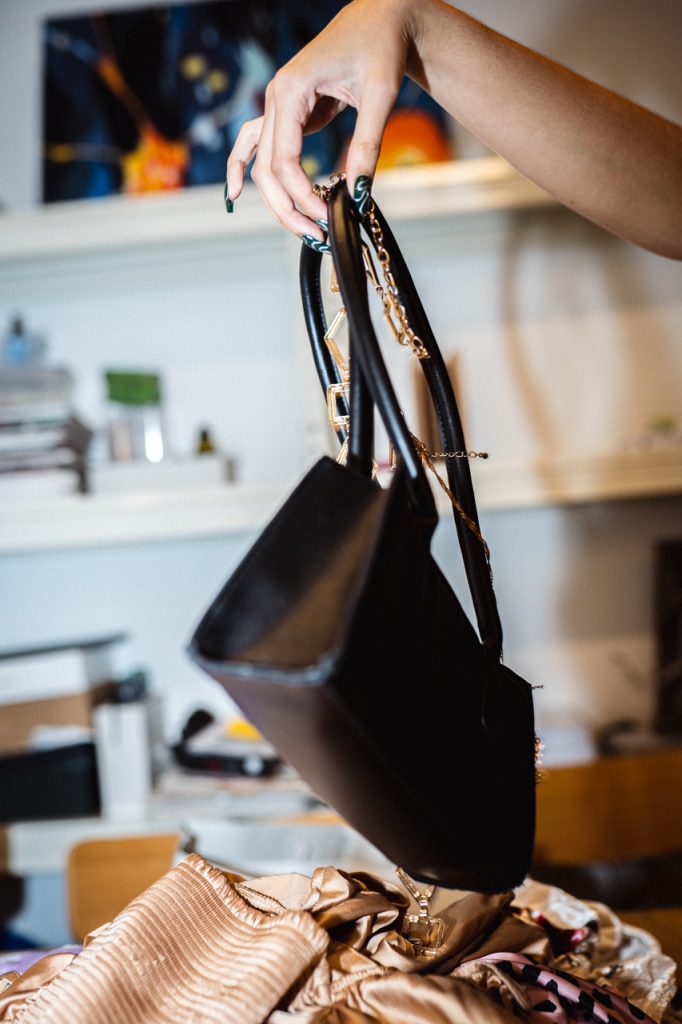Top illustration by Syada Yunos
All other images by Zachy Tang for RICE Media
My fashion sense involves buying plain shirts in multiple colours and wearing each of them to death.
You can imagine how this horrifies my friend, whose principle is “never rewear an outfit more than five times.”
ADVERTISEMENT
In other words, I’m the wrong target demographic for fashion ads online. Chances are, you’ve been ambushed (or haunted) by them at some point too. Perhaps from online retailers like SHEIN—the Chinese brand that’s long held an icky reputation for exploitation and pervasive online presence?
I’m curious, though. Even with the brand’s bad rep, they’ve amassed a cult-like following among its main target audience—Gen Z women. With youths being more ethically conscious these days, there must be something driving its peculiar demand. And I, as a non-fashion person, of course, need to know what that is.
So, What’s the Allure?
Fast fashion, simply put, refers to the rapid mass production of cheap stylish clothes. Quantity over quality forms a large part of their business model, and we all know about its catastrophic impact. Oftentimes, this results in significant environmental and labour issues.
Picture this: Out of 100 billion garments produced annually, 92 million tonnes of them end up in landfills. By 2030, that number is expected to rise by 50 percent.
Though they’re hardly the only fast fashion retailer, SHEIN is shouldering the bulk of negative press. The brand made headlines for alleged art theft and unfair labour practices. Viral posts on Instagram call out the alarming exploitation and lack of transparency happening in its factories.
Despite how problematic SHEIN comes across, its fans aren’t all that hard to find. You’d expect them to languish in shame away from the judging eyes of social media.
Yet, there they are, clear as day, touting haul after haul on TikTok and YouTube, giddy with excitement for the bargain outfits they’ve snagged.
22-year-old *Lyla is one such fan. Think of her as the Gen Z of Gen Zs—the person you’d trust for the latest trends.
To wit: Just as I reached out to her, she clinched a pair of sandals that, in her words, made her feel like “an early 2000s she’s-all-that girl.”

More items sit in her closet, she tells me. Who knows how much more will be added by the time this story goes live.
ADVERTISEMENT
“I wanted something that was younger and trendier. At one point, they were surprisingly hard to find,” Lyla explains when I asked her what the allure of SHEIN is.
“I remember Googling different fashion sites and this came up. At first, it was the usual—ASOS and H&M. But at one point, their pieces began to look bland. They didn’t keep up with the trends.”
For Lyla, the best part about SHEIN is that items are updated almost regularly. It’s unbelievably fast, unlike other platforms.

Indeed, the brand has an uncanny ability to match trends at breakneck speed and then sell them at a mysteriously low price. Their frenzied pace easily beats crowned sites like Zara, Forever 21 and Zaful, which are all, in some ways, also problematic in their own rights.
SHEIN takes the quantity-over-quality mantra to a whole new level. Apparently, they push out between 2,000 and 10,000 new items every day—and that’s not accounting for variations in sizes and colours yet.
For a better perspective, H&M listed 25,000 items in a 12-month period. SHEIN, within the same period, listed a whopping 1.3 million.
Guilt Can Wait
Lyla isn’t blinded by the perks of SHEIN. She’s well aware of the ethical issues.
Still, she shops frequently—almost once every month, in fact. With each order comes shoes, clothes, and even accessories like belts. Some will be repeatedly worn. Others will be barely touched.
When asked why she shops so often, Lyla shrugs. Sounding very much like a young person, she tells me that it’s hard for her to resist pretty things.
“There are just too many of them, and I’ve only got one life to experience them.” She also has an irrational pressure not to repeat outfits.
“I have this thing—a clothing cycle,” she tries to explain after seeing my brows furrow in confusion. “Somehow, I can’t wear the same thing to the same place. Unless it’s somewhere casual.”

Later, over text, she casually jokes about going on a personal challenge.
“Maybe I should refrain from buying clothes for three months.” Accompanying the text is a picture of a floral dress retailing for just $12.
“Look. I gotta show you how nice SHEIN clothes look so you can understand my pain.”
Lyla tells me that there was definitely some initial guilt, but that wasn’t enough to stop her from purchasing altogether. “If there’s something I don’t like, I can always return it anyway.”
From her perspective, many brands operate in a similar way, and they’ve each gone through their cycle of bad press. I sense a hint of defeatism from Lyla. Boycott or not, she doubts her actions make much of a difference.
The other big appeal, as most Singaporeans would know, is bargain hunting.
SHEIN’s items are already cheap, to begin with. And yet the brand knows exactly how to further draw shoppers in. All it takes is a sale here and a discount code there. It’s hard to resist a good steal.
Understandably, most Gen Zs aren’t financially stable just yet, so they’re naturally drawn to cheaper alternatives. “For those who are juggling a part-time job with their studies, yet are looking to enjoy life, SHEIN becomes a great choice,” Lyla stresses.
Out of Sight, Out of Mind
For many young shoppers, luxury isn’t always an affordable option. Expert buyers like Lyla circumvent this nagging problem rather expertly. She prides herself on knowing how to best navigate SHEIN, telling me it’s easy to piece an entire outfit on a budget.

Such retailers are great for consumers who don’t earn as much as their more privileged peers. And with this increased accessibility, a bigger group of people get to express themselves more freely too.
That said, the brand is not sustained by low-income groups alone. Not when those with far higher disposable income aren’t batting an eyelid when making large purchases.
The way I see it, influencers and celebrities are partially responsible for this. Try-on hauls easily go up to $2,000. People are spending way more than they need, and they aren’t exactly broke.
There’s so much more to unpack, and I’m aware that supporters of fast fashion aren’t completely to blame. They might just be victims of a wider over consumerist culture exacerbated by social media. There may be other reasons, of course, like our unconscious need to fit in.
In a recent podcast episode by The Financial Coconut, Sustainability Consultant Chu Wong breaks it down. “I believe that our addiction has a lot to do with our needs. What is this void that we’re trying to fill?”

It’s a question that begs individual soul-searching and reflection.
Chu did, however, point out the dangers of SHEIN’s low prices. “Of course, we want fashion to be affordable. But we don’t know what corners are cut.”
The biggest problem, she adds, is that we may start to see these items as disposable. According to Chu, only 4 percent of Singapore’s textiles are being recycled, while the rest gets incinerated and landfilled.
And thanks to our addiction to fast fashion, a large part of that waste ends up polluting the global South. That’s a huge amount of waste we’re not seeing every day.
True enough, Lyla agrees that purchasing habits might change if more people (including herself) actually witness the overwhelming state of waste or labour exploitation in real life.
For Lyla—and many of us—it’s out of sight, out of mind.
You’ve Got the Power
No major clothing brand is ethically perfect. In the name of sustainability, some even put forth greenwashed claims to exploit good intentions. Others would have you believe that the only way is by buying a pair of sweatpants for a whopping $129.
Truth is, there are plenty of other solutions if you’re looking to shop ethically.
Standing on the opposite spectrum of SHEIN-worshipping Gen Zs? Second-hand shoppers—thrift stores have been gaining popularity among youths in Singapore. These options certainly don’t break the bank (as much), and act as a great alternative to fast fashion.
For 25-year-old *Madeline, thrifting on Carousell is where the real thrill lies. As much as possible, she practices ‘wear and repeat’ with pride.

“If more people start thrifting, this helps extend the life of a piece of clothing,” she laments. “After reading about [fast fashion] controversies, I’ll never get over the guilt. Especially if I put myself in the shoes of the workers.”
This emerging trend should be one to celebrate. “In fashion, the most sustainable thing you can do is to actually rewear clothes for much longer,” Chu notes in the podcast.
“Ultimately, you cannot separate the human impact of the fashion industry from its environmental impact. They’re very intricately linked.”
While I don’t consider myself fashionable, I’ve learned that it doesn’t dissolve me from responsibilities. Even if we’re only buying for pragmatic reasons, Chu notes that we’re still part of the fashion system. It’s good practice to first think about whether the brand aligns with our values, she says.
“Often, garment workers are stuck in the poverty cycle where they don’t earn enough to pay for their rent or food on the table. We kinda need to stop it,” she emphasises.
“As consumers, we sometimes forget that we are the ones who hold the power.”
Self Control: A Tall Order
An impulse purchase here, an add-to-cart there. Who’s really getting hurt?
Clothes, in a sense, are ghosts of some idealised version of ourselves. Often, what’s bought ends up thrown or hung limply in closets collecting dust. If it’s up to me, the solution seems simple: Buy less, thrift, or don’t buy at all. That, however, is a tall order.
It’s hard fighting against mega institutions when the market demands it. This moral game is tricky. Pessimistic as it sounds, I doubt fast fashion can ever be eradicated.
Changing this system will be hard. It’s true that SHEIN is only just one of the many retailers. Now that one supplier has cracked the code, it’s only a matter of time before another takes over the throne.
In Lyla’s words, “there will always be a new bad guy.”
*Pseudonym used to protect profile’s privacy.







